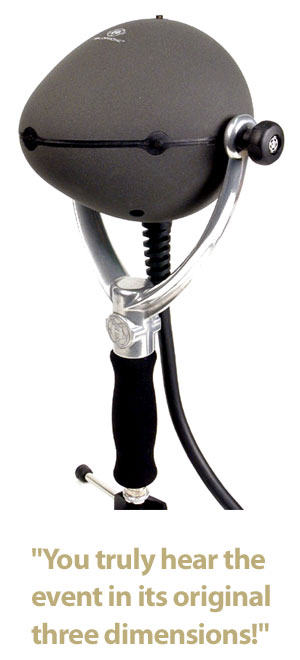- No products in the cart.

It is important to remember that the goal of a surround microphone is to record a natural acoustical “image” that gives the listener the sensation, as closely as possible, that they are actually present during the recorded event. The Holophone comes closest to achieving this goal than any other microphone or microphone array that I am aware of.
In recent years there have been several entries for what inventors thought a surround microphone should be. With the best intentions, widely varying designs ranged from the amusing to the ridiculous, and many were reminiscent of the first attempts of building an airplane before that first flight.
The Holophone has taken off. And as is usually the case for winning designs, the winning Holophone surround microphone is a combination of proven principals, innovation, and simplicity.
The Holophone captures a surround image with miniature elements made by DPA (Danish Pro Audio). With roots from B&K (manufacturers of test instrument transducers), DPA is renowned for very accurate, high quality microphones. The microphones are positioned flush around the surface of an oval shaped ball, mimicking the proportions of the 5.1, 6.1, and 7.1 surround speaker array standards.
The result, when played back through a surround speaker system is remarkably eerie. You truly sense the event in its original three dimensions. Not only can you sense the position of sounds to the front, left, right, or behind, but you can also sense how far or how close the sounds are. With 6.1 surround (the IMAX addition of a top element), you can more accurately even sense the ambience above. We are all too familiar with the gimmicky effects surround systems are used for, but a natural 3 dimensional image was always the goal of the designers.
What is “5.1” “6.1” and “7.1”?
When coming up with a standard for surround sound, the goal was simple: The most practical way to achieve a natural “being there” acoustical image. Of course, the more speakers corresponding with equal number of separate tracks that surround the listener the better, but remember the key word practical. It was determined that 5 speakers – placed left front, front, right front, left rear and right rear – was the most practical. In other words, to make a significant improvement would take a very large increase in the number of speakers and recorded tracks. These 5 speaker positions are the “5” in 5.1
All things artistic are debatable, and some felt that the dimension above the listener was equally important, so IMAX uses a 6.1 system that adds a top element. Sony decided that the difference made by 3 speakers in the front was also important to the back, the Sony Digital Dynamic Sound (SDDS) uses the 7.1 standard which adds two channels to the back (but no top element).
It is important to note that the Holophone microphone supports all three of these standards.
But what is the “point one”?
Adding all of these tracks meant more of everything, including more power from the speaker amplifiers and more noise because of the number of tracks. Since most of the power robbing and bandwidth robbing signal usually comes from the lowest frequencies, and because very low frequencies are not sensed very directionally, an economic opportunity in physics was taken advantage of: It was decided to put all the lowest frequencies on one channel and play them through one large bass speaker known as a subwoofer. The channel going to the subwoofer is the “point one” of the 5.1, 6.1, and 7.1 surround standards.
It is common practice to sum all the lowest frequencies (say, below 60Hz) from all of the 5 or 7 channels, and route them to the point-one channel. The argument for this being acceptable is due to the long wavelengths of frequencies below 60Hz making phase cancellation insignificant. That argument is at least somewhat valid, but the designer of the Holophone went all out to be safe, adding a dedicated “point-one” microphone inside the Holophone array.
This is why the Holophone microphone has 8 outputs: for 5.1 you use left front, front, right front, left rear, right rear, and “point-one” channels, and for 6.1 the additional top mic is used, and for 7.1 the additional two rear channels are used.
Categories:
Microphones, Reviews
One comment
Leave a reply Delete Message
You must be logged in to post a comment.


 US
US  Canada
Canada 


A normal home theater system contains of 5-7 speakers, including center channel for voice, high quality DVD player, HDTV, cables, projects
along with accessories. The audio systems are now being designed and manufactured
by specialized companies who will be catering to this segment.
Then you need to cut some speaker's wire into lengths of twelve inches, stripping
a 50 % of an inch of insulation of the wires at intervals of end around the lengths.